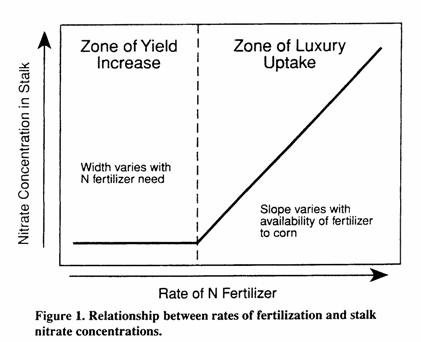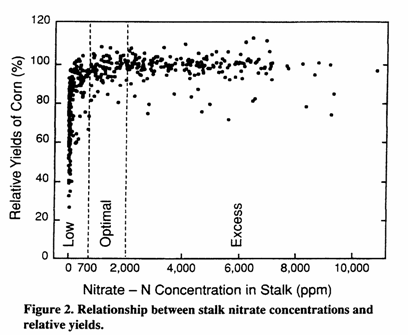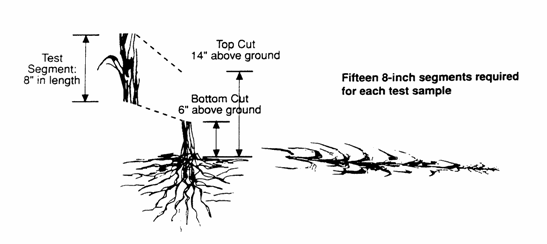End Of Season Cornstalk Nitrate Test
Studies at Iowa State University (ISU) have shown that the nitrogen (N) status of a corn crop can be evaluated by measuring nitrate concentrations in the lower portion of cornstalks at the end of the growing season. This finding led to the development of a new tissue test that can be used to evaluate N management practices. Information in this paper relating to plant sampling and the interpretation of this test has been taken from their publication “Cornstalk Testing to Evaluate Nitrogen Management”, Pm-1584, Aug. 1994.
Purpose of the Test
Studies at ISU concluded that many producers were applying excess N for optimum corn profitability. They further concluded that by using the Pre-Sidedress Soil N Test (PSNT) and the end-of-season cornstalk nitrate test (CSNT), producers could increase their profits by identifying the most profitable N rate for their fields.
According to ISU researchers, the underlying reasons for over-fertilization are that 1) producers tend to fertilize to maintain dark green plants late into the growing season and that 2) corn plants show no visual symptoms of excess N availability. They question the practice of maintaining dark green plants late into the season, because corn leaves tend to lose their deep green color late in the season at economically optimal rates of fertilization. The end-of-season cornstalk test, therefore, helps producers distinguish between fertilizing to maximize greenness and fertilizing to maximize profits.
Existing leaf and grain analysis is better calibrated to identify nutrient shortage, rather than excess. Therefore this test offers a tool that producers and those that advise them may find useful.
Basis for the Test
The lower portion of a corn stalk tends to function like a reservoir for nitrate N (NO3-N). Corn plants suffering from inadequate N availability tend to remove N from this reservoir, as well as from lower leaves during the grain-filling period. Conversely, corn that has more N than required to achieve top yields based on other existing conditions will tend to accumulate nitrate in their lower stalks at the end of the season.
ISU established relationships between yields and stalk nitrate concentrations in trials having N fertilizer applied at rates ranging from 0 to 300 lb. N/acre. The studies were conducted at many sites over several years to include a wide range of soil, management, and weather conditions.
Calibration studies showed that small increases in rates of fertilization tended to produce one of two kinds of response (see Figure 1).
- A yield increase with little or no increase in stalk nitrate concentration.
- An increase in stalk nitrate concentration with little or no increase in yield (luxury uptake).
The first type of response indicates that supplies of available N were limiting plant growth at the end of the season, while the second indicates that supplies of available N were not limiting growth during this period. These response patterns enable a producer to determine if the cop had adequate N late in the growing season.
The results of all trials were combined into a common relationship between stalk nitrate concentrations and relative yields (see Fig. 2). Some relative yields slightly above or below 100 percent should be expected because measured yields tend to differ slightly among plots having ample N.
Interpreting Results
| Low | less than 250 ppm N |
|---|---|
| Marginal | 251-700 ppm N |
| Optimal | 701 to 2000 ppm N |
| Excess | greater than 2001 ppm N |
The Low category indicates high probability that greater availability of N would have resulted in higher yields. It should be noted that concentrations in this range give little indication of the magnitude of yield increase that might be expected from more available N. Visual signs of N deficiency usually are clear when nitrate concentrations are in this range.
The Marginal category is where the nitrogen program should be re-evaluated. Visual signs of N deficiency often are observed in this range.
The Optimal category indicates high probability that N availability was within the range needed to maximize profits for the producer. The higher end of this range is more appropriate when fertilizer N is relatively inexpensive and grain prices are relatively high. The lower end of the range is most appropriate when fertilizer N is relatively expensive and grain prices are relatively low.
The Excess category indicates high probability that N availability was greater than if fertilizer N had been applied at rates that maximize profits for producers.
The ISU reports on this research do not discuss in the visual N deficiencies mentioned above in any detail. However, some readers may be lead to assume that visual N deficiency symptoms are not a significant concern. One would have to assume that the visual symptoms mentioned occurred very late in the season, and hopefully near or after black layer development. If this is so, then it would seem likely that the visual deficiency symptoms were not indicative of yield loss. However, if visual deficiency symptoms appeared during or prior to grain-fill, experience indicates that yield loss would be expected.
Considerations
When using this test, remember that it indicates the “Relative” amount of N uptake by the corn that season. This is important because a Low or Excessive result can have two different meanings.
- It can mean that the N application rate was inappropriate
- It can mean that unique growing conditions in that season did not “match” the N rate. For example, an extreme drought or other yield-limiting factor could limit corn growth to such an extent that an otherwise correct N rate would seem excessive for the unique growing conditions and yields achieved in that year.
ISU included the following comments and observations about this test.
- The concentration of nitrate in the stalk at the end of the season reflects all factors that influenced N availability and N needs during the growing season. Many factors influence N availability after fertilizers are applied, and it is unrealistic to expect any producer to attain optimal N concentrations in all fields in all years. Experience has shown that the optimal range is difficult to consistently attain with existing management practices.
- When interpreting the results of the test, consideration must be given to weather conditions that occurred during the growing season. Rates of fertilization that are most profitable over many years should be expected to result in low concentrations in some years and in excess concentrations in other years.
- Lower-than-desired concentrations should be expected in years having unusually large amounts of in-season rainfall that results in unusually large losses of N and (or) high yield potential. Higher-than-desired concentrations should be expected in years when unusually low rainfall limits N losses and (or) yield potential.
- It is possible that N deficiencies early in the growing season sometimes limit yield potential in ways that are not directly indicated by the stalk test. Additions of more fertilizer than needed after such damage has occurred will result in concentrations of stalk nitrate that correctly indicate that higher rates of fertilization would not have increased yields. This problem is avoided if enough N is applied before planting or if the Pre-Sidedress Soil N Test is routinely used to ensure that such deficiencies are unlikely.
- After appropriate consideration is given for weather conditions, fertilization rates should be increased for areas that usually test in the low range and decreased on areas that usually test in the excess range. The test does not directly indicate how much N rates should be increased or decreased, but continued use of the test for several years enables producers to make adjustments toward optimal rates. Concentrations in the excess range indicate that use of the late-spring soil test to guide N fertilization will probably increase profits for the producer.
Taking the Sample
- The time for sampling is between 1 and 3 weeks after black layers have formed on about 80 percent of the kernels of most ears.
- The portion of each plant sampled is the 8-inch segment of stalk found between 6 and 14 inches above the soil. Leaf sheaths should be removed from the segments. Stalks severely damaged by disease or insects should not be used.
Fifteen 8-inch segments should be collected to form a single sample to be sent for analysis. Areas differing in soil types or management histories should be sampled separately. Collecting one composite sample from each of several small areas (less than an acre) that seem to be representative of larger areas within a field is an effective strategy.
- Samples should be sent to Spectrum Analytic for analysis as soon as possible after collection. Samples should be placed in paper (not plastic) bags to enable some drying and minimize growth of mold. Samples should be sent by a reliable 2 day service. If the sample is to be stored for more than a day before mailing, it should be refrigerated (but not frozen).
- Once Spectrum Analytic receives the samples, we will dry the samples. The samples will be ground and analyzed for nitrate N concentrations. Concentrations are expressed as ppm (parts of nitrate-N per million parts of dry stover).
Cornell University Cooperative Extension
Taking a Corn Stalk Nitrate Test Sample After Corn Silage Harvest
If the silage cutting height in the field exceeds 14 inches, they suggest collecting the standard 8 – inch section of stalk from the 6 – 14 inch height. When stubble height is less than 14 inches but greater than 8 inches, stalk samples can be taken between 2 and 8 inches off the ground. In order to use the standard interpretation of Nitrate-N (NO3-N) level that was published by Iowa State University and others, the Nitrate-N, ppm levels will need to be converted because stalk nitrate levels are higher in the lower portions of the stalk. With 2-8 inch samples, laboratory values need to be divided by 1.5 (6-14 inch stalk nitrate-N results ppm/1.5) for the test results to be comparable.
According to Cornell bulletin stalk samples may be taken at silage harvest (60-70% moisture) and grain harvest (20-30% moisture) without any major effect on the corn stalk nitrate test results. Collecting samples in the field up to five days after harvest will not affect corn stalk nitrate results (assuming no significant rainfall, soil disturbance or manure application in that time period).


